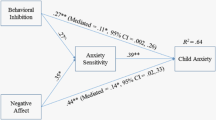Abstract
This study investigated the role of control beliefs in childhood anxiety disorders. The sample comprised 117 youth aged 9–17 years (86 met diagnostic criteria for an anxiety disorder and the remaining 31 were nonreferred comparison participants). Participants' anxiety levels and their perceptions of control over anxiety-related events (e.g., “things that might be harmful,” “feeling shaky or nervous”) were assessed. Findings indicated that perceived control over anxiety-related events was significantly negatively correlated with self-reported anxiety levels. Moreover, youth with anxiety disorders reported significantly lower perceived control about anxiety than the nonreferred participants. Findings were consistent with theory and suggest that anxiety disorders in youth are associated with beliefs that anxiety is uncontrollable.
Similar content being viewed by others
References
Albano, A. M., & Silverman, W. K. (1996). Anxiety Disorders Interview Schedule for DSM-IV Child Version: Clinician Manual. San Antonio, TX: Psychological Corporation.
Barlow, D. H. (1988). Anxiety and its disorders: The nature and treatment of anxiety and panic. New York: Guilford Press.
Barlow, D. H. (2002). Anxiety and its disorders: The nature and treatment of anxiety and panic(2nd ed.). New York: Guilford Press.
Beck, A. T. (1976). Cognitive therapy and the emotional disorders. New York: International Universities Press.
Beck, A. T. (1985). Theoretical perspectives on clinical anxiety. In A. H. Tuma & J. D. Maser (Eds.), Anxiety and the anxiety disorders(pp. 183-196). Hilsdale, NJ: Earlbaum.
Chorpita, B. F., & Barlow, D. H. (1998). The development of anxiety: The role of control in the early environment. Psychological Bulletin, 124, 3-21.
Cohen, J. (1988). Statistical power analysis for the behavioral sciences(2nd ed.). Hilsdale, NJ: Earlbaum.
Ellis, A. (1962). Reason and emotion in psychotherapy. New Jersey: Citadel Press.
Epkins, C. C. (1996). Cognitive specificity and affective confounding in social anxiety and dysphoria in children. Journal of Psychopathology and Behavioral Assessment, 18, 83-101.
Flesch, R. (1948). A new readability yardstick. Journal of Applied Psychology, 32, 221-233.
Leitenberg, H., Yost, L., & Carroll-Wilson, M. (1986). Negative cognitive errors in children: Questionnaire development, normative data, and comparisons between children with and without self-reported symptoms of depression, low self-esteem and evaluation anxiety. Journal of Consulting and Clinical Psychology, 54, 528-536.
Leung, P. W. L., & Wong, M. M. T. (1998). Can cognitive errors differentiate between internalizing and externalizing problems. Journal of Child Psychology, Psychiatry and Allied Disciplines, 39, 263-269.
Lipsey, M. W. (1990). Design sensitivity: Statistical power for experimental research. London: Sage.
Nowicki, S., & Strickland, B. (1973). A locus of control scale for children. Journal of Consulting and Clinical Psychology, 40, 148-155.
Nunn, G. D. (1988). Concurrent validity between the Nowicki–Strickland Locus of Control Scale and The State–Trait Anxiety Inventory for Children. Educational and Psychological Measurement, 48, 435-438.
Ollendick, D. G. (1979). Locus of control and anxiety as mediating variables of locus of conflict in disadvantaged youth. The Journal of Psychology, 101, 23-25.
Rapee, R. M., Craske, M. G., Brown, T. A., & Barlow, D. H. (1996). Measurement of perceived control over anxiety related events. Behavior Therapy, 27, 279-293.
Rawson, H. E. (1992). The interrelationship of measures of manifest anxiety, self-esteem, locus of control and depression in children with behavioral problems. Journal of Psychoeducational Assessment, 10, 319-329.
Reynolds, C. R. (1981). Long-term stability of scores on the Revised-Children's Manifest Anxiety Scale. Perceptual Motor Skills, 53, 702.
Reynolds, C. R., & Richmond, B. O. (1978). What I think and feel: A revised measure of children's manifest anxiety. Journal of Abnormal Child Psychology, 6, 271-280.
Rotter, J. B. (1975). Some problems and misconceptions related to the construct of internal versus external locus of control of reinforcement. Journal of Consulting and Clinical Psychology, 43, 56-67.
Shriberg, L. D. (1974). Descriptive statistics for two children's social desirability scales, general and test anxiety, and locus of control in elementary school children. Psychological Reports, 34, 863-870.
Silverman, W. K., & Albano, A. M. (1996). Anxiety Disorders Interview Schedule for DSM-IV Child Version. San Antonio, TX: Psychological Corporation.
Silverman, W. K., Saavedra, L. S., & Pina, A. A. (2001). The Anxiety Disorders Interview Schedule for Children. Journal of the American Academy of Child and Adolescent Psychiatry, 40, 937-944.
Spielberger, C. D. (1973). Manual for the State–Trait Anxiety Inventory for Children. Palo Alto, CA: Consulting Psychologists Press.
St-Yves, A., Dompierre, S., Freeston, M. H., Jacques, C., & Malo, M. (1989). Locus of control and anxiety in children from intact and maritally disrupted families. Psychological Reports, 65, 855-860.
Tabachnick, G., & Fidell, L. S. (1996). Using multivariate statistics(3rd ed.). Northridge, CA: Harper Collins.
Thomas, G., Hartley, D. R., & Kincaid, P. J. (1975). Test–retest and inter-analyst reliability of the Automated Readability Index, Flesch Reading Ease Score, and the Fog Count. Journal of Reading Behavior, 7, 149-154.
Weems, C. F., Berman, S. L., Silverman, W. K., & Saavedra, L. S. (2001). Cognitive errors in youth with anxiety disorders: The linkages between negative cognitive errors and anxious symptoms. Cognitive Therapy and Research, 25, 559-575.
Weisz, J. R., Thurber, C. A., Sweeney, L., Proffitt, V. D., & LeGagnoux, G. L. (1997). Brief treatment of mild-to-moderate child depression using primary and secondary control enhancement training. Journal of Consulting and Clinical Psychology, 65, 703-707.




